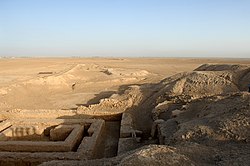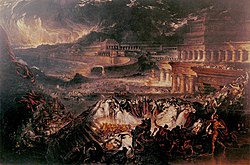Nabopolassar
Nabopolassar was the first king of the Neo-Babylonian Empire he reigned from 626 BC to 605 BC.
| Nabopolassar | |
|---|---|
 Clay cylinder of Nabopolassar from Babylon | |
| King of the Neo-Babylonian Empire | |
| 22/23 November 626 BC – July 605 BC[1][2] | |
| Predecessor | Sinsharishkun (Neo-Assyrian Empire) |
| Successor | Nebuchadnezzar II |
| Born | c. 658 BC[3] Uruk (?) |
| Died | 605 BC[3] (aged c. 53) Babylon |
| Issue | Nebuchadnezzar II Nabu-shum-lishir Nabu-zer-ushabshi |
| Akkadian | Nabû-apla-uṣur |
| Dynasty | Chaldean dynasty |
| Father | Kudurru (?) |
Nabopolassar Media
The ruins of the city of Uruk, where Nabopolassar and his family may have originated
The so-called "Chronicle of Nabopolassar". The cuneiform inscriptions on this clay tablet narrate the chronicle of the years 608-605 BC. After the fall of Nineveh, Naboplolassar vied with Egypt to control Assyria's western territories. His death stopped the campaign and sent his son Nebuchadnezzar II back to Babylon to claim the throne
In the latter part of the Neo-Assyrian king Ashurbanipal's (pictured) reign, when Babylonia was governed by his appointed vassal king Kandalanu, Assyria and Babylonia enjoyed a long period of peace. Nabopolassar's revolt began in the period of turmoil following the deaths of both Ashurbanipal and Kandalanu.
The Uruk King List (pictured), which records the lengths of the reigns of Babylonian monarchs from the 7th to 3rd century BC, is one of the sources that can be used to date Nabopolassar's reign.
Locations of some major Mesopotamian cities
Letter from Sinsharishkun to Nabopolassar (c. 613 BC) wherein Sinsharishkun attempts to broker peace, pleading to be allowed to retain his kingdom. The authenticity of the letter is a matter of debate.[4]
Fall of Nineveh by John Martin (1829)
The Battle of Carchemish, as depicted in Hutchinson's Story of the Nations (1900)
References
- ↑ Lipschits 2005, p. 14.
- ↑ Parker & Dubberstein 1942, p. 9.
- ↑ 3.0 3.1 Garrison 2012, p. 43.
- ↑ Da Riva 2017, p. 81.








